|
Jump All photos by the author. |
Travel Overview Page 3 of 4, Continued... Page 1 Page 2 Page 4
China as a subject came as a welcome series of surprises. Two big cities, Beijing and Shanghai crossed in front of the lens. When one encounters a major crowd-pleaser like the Great Wall, standard images can be taken, or the thing can become the subject of interesting non-standard shots. I try to get a bit of each.  The Great Wall at Badaling. --Olympus E-1.
Beijing is big. Feet are small. Rest is required. Olympus E-1.
Race you to the end! Olympus E-1 / 50-200mm Zuiko lens. The wall extends left and right from any given entry point and we took the harder, steeper, more difficult branch to the left so we could get pictures of people struggling instead of simply snapping shots of leisurely visitors. That branch offered better vistas, too, I swear, and we came back with images that prove your (and my) opinion of what qualifies as "steep" is due for major revision. Portions of the Wall were as near vertical as one could build and still have the pathway negotiable by humans. A mile or two from the entry point the restored portion of the wall gave way to more miles of wall in its un-restored condition.
Chongqing (pronounced Chung-ching) sounds like an old fashioned cash register when you hear it spoken. It sits mainly on bluffs high overlooking the long Yangtze River--an ancient waterway used since prehistoric time for navigation but prone to occasional bouts of treachery. Until recently the Yangtze claimed thousands of lives every time it flooded. 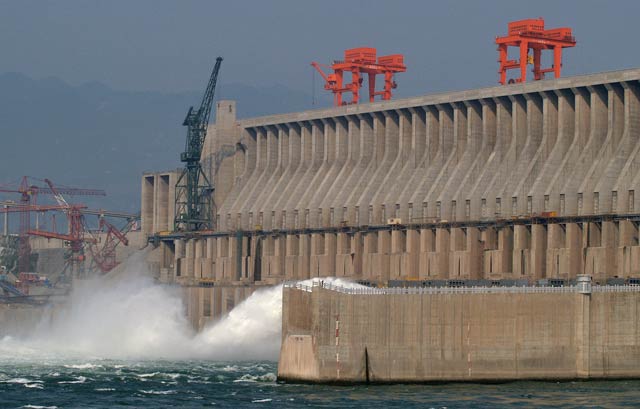 Nothing in this image can give you an immediate sense of scale. Try this: Those orange mobile cranes on top are in the range of 10 stories tall. --Olympus E-1 with 50-200mm Zuiko tele zoom. To control this wild river and improve navigation a project began construction in 1993 and is nearing completion. The world's largest dam is nearly finished, lifting the river by a total of 175 meters by 2009. Only 36 more meters to go! But this means relocating millions of people, farms, dwellings and even whole cities up to higher ground. And when it is finished, areas of rapids will be well under water allowing ships to plunge inland to service the country's growing economy. 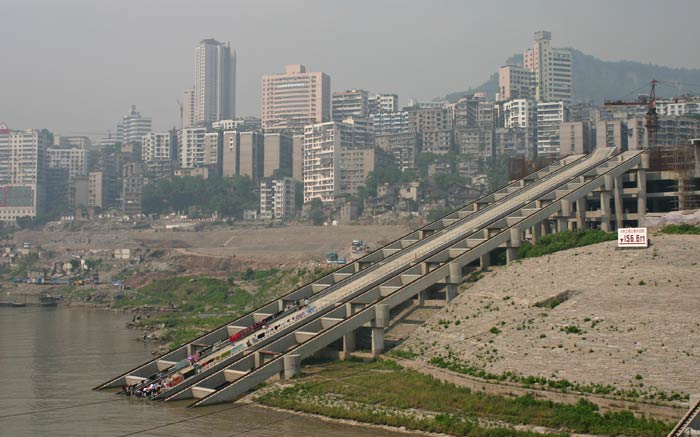 Abandon the waterfront on the Yangtze. Build a ramp that can launch an arc! City of Wan Zhou. --Canon 300D. Today ships that ply the river are only about 3500 tons, a third of the size of the ones the future will host. So it's an ideal time to get a last look at the grandeur of the famous "Three Gorges" -- areas of vertical cliffs, narrow river passage and immense scenic beauty -- before they're 36 meters less dramatic.  Picturesque island doomed to become river bottom before 2009. --Olympus E-1. We boarded a boat for a four day ride down the Yangtze featuring side trips into interesting towns and up scenic tributaries. 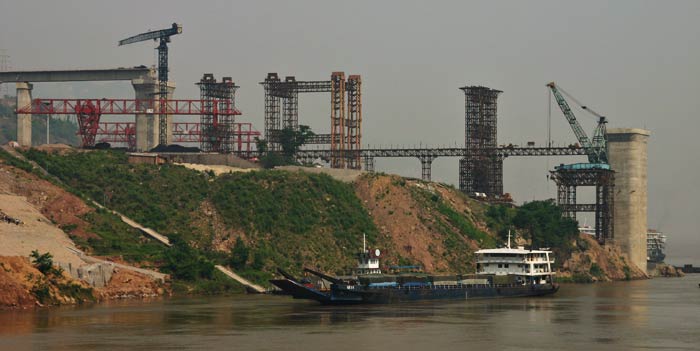 ...and get that bridge finished before the Big Flood. --Canon 300D. Do not ask me why, but the upper Yangtze has floating strings of flotsam and jetsam visible in mid-river. Among the debris is a high population of white Styrofoam chunks (no surprise there) and --get this-- shoes! Recognizable from their shape, rubber soles float, looking like disembodied footsteps on the water's surface. 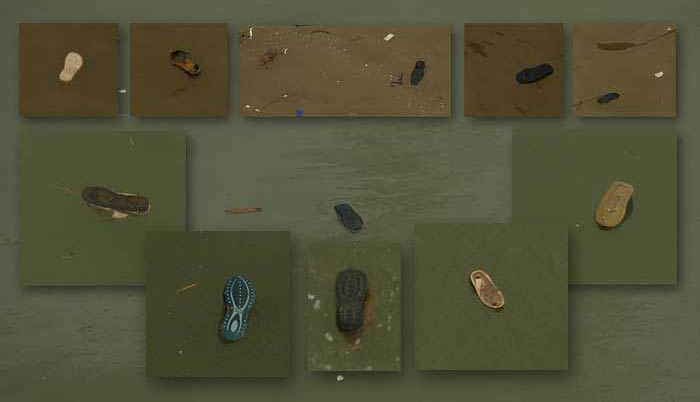 Lost Shoes of the Yangtze. --Various cameras. What happened? Did a shoe factory fall into the river? Or are people just amazingly careless with their feet around the water's edge? Many were sandals but high-tech running shoes were spotted sole-fully, too. Pairs weren't together, just single examples of each style. Nobody had an answer as to how they got in the water, and everyone we talked to didn't seem to be missing one. 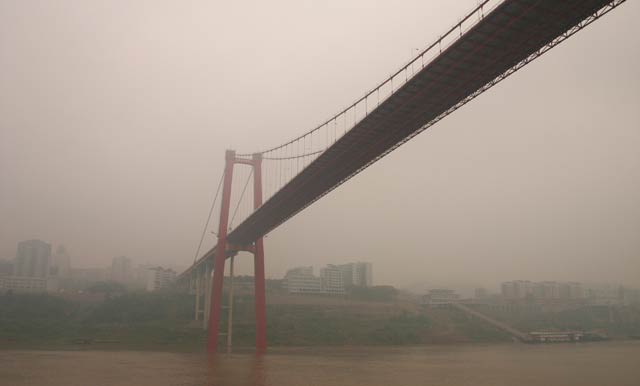 Fog Span. One of several new bridges crossing the Yangtze in the Three Gorges area. --Canon 300D. Canon Kit lens. New bridges are spanning the river at dozens of places between Chongqing and The Dam. New designs of high tech spans are common and all seem amazingly high, today, since the river has so far to rise before The Dam is fully filled. Cities along the water's edge are moving on up. New apartment houses dot the hills while old ones are being demolished down by the waterfront.  Hilltops along the Yangtze have become prime real estate. --Canon 300D / Sigma 28-200 tele zoom. Some of the boats are purely utilitarian, others cater to several categories of tourist. One, looking at first like an old Mississippi River Gambling boat, turned out to be filled several stories deep with brand new utility trucks.  I'll see your bet and raise you fifty step-vans. --Olympus E-1. Continued on Overview Page 4 -->
All rights reserved. Do not reprint. Do not link to images. Reprinting except for newsworthy mention and brief quotes are by permission only |
 Chinese Impressions, Expressions, Exposures and
Closures
Chinese Impressions, Expressions, Exposures and
Closures People are always great subject matter and it quickly
became obvious that every person in China had a camera or two.
Most of them being small digitals. It is not difficult to see
hundreds of pictures being posed by local residents and visitors
in places like Tien An Men Square where everybody goes to be
with everybody else. We went several times and when it rained,
the subject matter changed from kite fliers to umbrella carriers.
People are always great subject matter and it quickly
became obvious that every person in China had a camera or two.
Most of them being small digitals. It is not difficult to see
hundreds of pictures being posed by local residents and visitors
in places like Tien An Men Square where everybody goes to be
with everybody else. We went several times and when it rained,
the subject matter changed from kite fliers to umbrella carriers.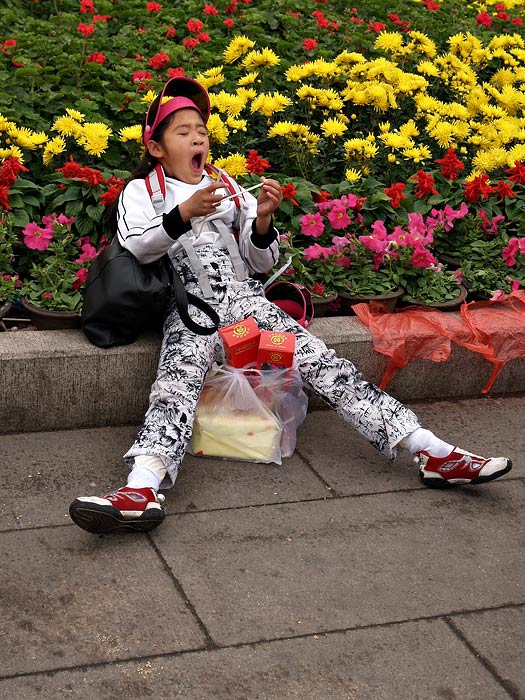 Beyond
Tien An Men lies the no-longer-Forbidden City, a complex of thousands
of picture opportunities and narrow passages once inhabited by
emperors and their support crews. Forbidden to the commoners,
it presents a mix of big impressive structures and small living
quarters all packed into a footprint the size of a small airport.
Very ornate, it is one of those places you would like to visit
but living there would be tedious beyond endurance. The day we
visited, park attendance was 1.2 billion. It seemed.
Beyond
Tien An Men lies the no-longer-Forbidden City, a complex of thousands
of picture opportunities and narrow passages once inhabited by
emperors and their support crews. Forbidden to the commoners,
it presents a mix of big impressive structures and small living
quarters all packed into a footprint the size of a small airport.
Very ornate, it is one of those places you would like to visit
but living there would be tedious beyond endurance. The day we
visited, park attendance was 1.2 billion. It seemed. The Great Wall itself is nothing short of amazing.
Nobody can ever see more than a fraction of it at any given time,
but the destination, Badaling, is well populated by tourists,
military guards and a number of miles of wall that has been restored
to near-new condition. The theory behind it is that good fences
keep out bad neighbors. They could have saved a lot of effort
by simply hiring their neighbors to the north to do their manufacturing.
Hey, it worked for the West over the last 10 years, right?
The Great Wall itself is nothing short of amazing.
Nobody can ever see more than a fraction of it at any given time,
but the destination, Badaling, is well populated by tourists,
military guards and a number of miles of wall that has been restored
to near-new condition. The theory behind it is that good fences
keep out bad neighbors. They could have saved a lot of effort
by simply hiring their neighbors to the north to do their manufacturing.
Hey, it worked for the West over the last 10 years, right? It has been repeated to infinity that the Great
Wall is the only man-made thing visible from Earth orbit. Pffft!
Side to side it is rarely 20 feet and from space it would look
far narrower than any paved street. Astronauts frequently try
to spot it from outer space without success, but every man-made
city is immediately recognizable from space. "Just follow
that easy to see highway out from Beijing and --yep!-- there
it is; the Great Wall, a skinny line wiggling across the landscape.
Here, use the binoculars..."
It has been repeated to infinity that the Great
Wall is the only man-made thing visible from Earth orbit. Pffft!
Side to side it is rarely 20 feet and from space it would look
far narrower than any paved street. Astronauts frequently try
to spot it from outer space without success, but every man-made
city is immediately recognizable from space. "Just follow
that easy to see highway out from Beijing and --yep!-- there
it is; the Great Wall, a skinny line wiggling across the landscape.
Here, use the binoculars..."
 Get
the eBooks
Get
the eBooks